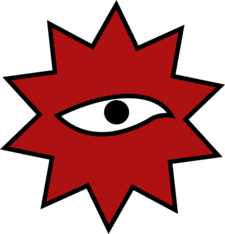Astikism
This article is incomplete because it is pending further input from participants, or it is a work-in-progress by one author. Please comment on this article's talk page to share your input, comments and questions. Note: To contribute to this article, you may need to seek help from the author(s) of this page. |
| Astikism | |
|---|---|
 The Eye of Achat, the symbol of Astikism | |
| Classification | Artadesian Religions |
| Scripture | Artasya Avagamanam |
| Theology | Henotheism |
| Region | Astraleaux |
| Language | Artik |
| Founder | Astika |
| Origin | WIP BC Artadesia |
Astikism (Artik: Ārtasyayajña transl. Worship of Righteousness) is a henotheistic religion based on the teachings of the prophet Astiki, namely that God (Achat) is an indivisible, timeless, formless, and deathless being, and that It commands 10 Bhratis (transl. "Elevated Ones"). It is one of the most practiced religions in the world, with around [TBD] million followers, known as Astikites. The religion is primarily practiced in Artadesia and among the Artadesian diaspora. The Astikite name for God, Achat, comes from the belief in Its indivisibility. The primary scriptures of Astikism are the Artasya Avagamanam, "Understanding of Righteousness", a compilation of the life of Astiki and his revelations.
Astikism was formed around the 600s BCE as an offshoot of Vidanism, and took many concepts and inspiration from Vidanism. The Prophet Astika is believed to have been born in Spentavrat, and walked across much of Artadesia from what is now central Mehrdesh to what is now eastern Chorap. He espoused principles of anti-kingship, egalitarianism, and a cosmic struggle between good and evil, and soon Astikism was a dominant force in much of central Artadesia. After Astika's death in the mid-500s BCE, Astikism grew to become a dominant religion in nearly all of Airyavej, and around 470 BCE, the great-great-grandson of Astika, Sadvicarah I founded the First Realm of God, which would conquer much of modern Artadesia, spreading the faith. The First Realm of God would standardize the faith, codifying the Artasya Avagamanam and introducing a concise code of Astikite law. The faith would continue to spread until around the 1st Century CE, when the expansion of the First Realm stagnated. Splits began to form in Astikism, mainly the split between the Orthodox Guiding Hand (Artik: Artātmā Mārgardarśakahastaḥ) and the Guiding Hand of Exaltation (Artik: Utthānasya Mārgardarśakahastaḥ), which gained popularity in Chakhadesh and Chorap. Other minor splits occured, however none were major, until the split of the Guiding Hand of Liberation (Artik: Muktyāḥ Mārgardarśakahastaḥ) in 1913, spearheaded by Satrap Humayun. The Guiding Hand of Liberation became the most influential Guiding Hand in Artadesia under the Councilist government of A.K. Maurya. Astikism has played a major role in the development of Artadesian civilization, and has been integral to Artadesian culture.
The three largest branches of Astikism are Liberation Astikism (X adherents), Orthodox Astikism (X adherents), and Exalation Astikism (X adherents). Other smaller branches do exist, however their influence is mostly regional. In Artadesia, Astikism is the dominant religion, with the vast majority of Artadesians practicing Astikism. Astikism is also influential elsewhere in Sorenway, particularily in regions which have been historically close to Artadesia.
Etymology
The term Āstika means "believer" in Artik, and was most likely not the true name of Astika but rather a name he adopted. The use of the word Astikism to describe the religion is Marisian in origin, and most Artadesians refer to it with the name "Artasyayajna" (transl. "Worship of Righteousness" ), from the genitive form of Arta, meaning "Righteousness" or "The Cosmic Order", and Yajna, meaning "Worship".
Beliefs
Confession of Belief
The Astikite confession of belief is a ritual undergone by all converts to the religion, which is typically done by reciting the Prathamaṃ Prakāśanam (transl. "First Revelation" ), whose expanded form iss:
Praise be unto the Great Lord! Praise be unto the Great Lord who rules in the Heavens and presides over the Earth! Praise be heaped onto the Indivisible One whose form is most divine and who’s actions are most elucidated! May you grant understanding to me, The Follower, may you grant wisdom and truth to me, o Great One! May the evil forces which are of Urjak Manu be dispelled easily,may your great warriors whom are uncountable and infinitely faithful crush them!
This statements starts every book in the Artasya Avagamanam, and is often recited as the first prayer during worship. It is intended to cover the main tenets of Astikism, mainly of Achat's power, his indivisible nature, and the doctrine of hatred of Urjak Manu.
